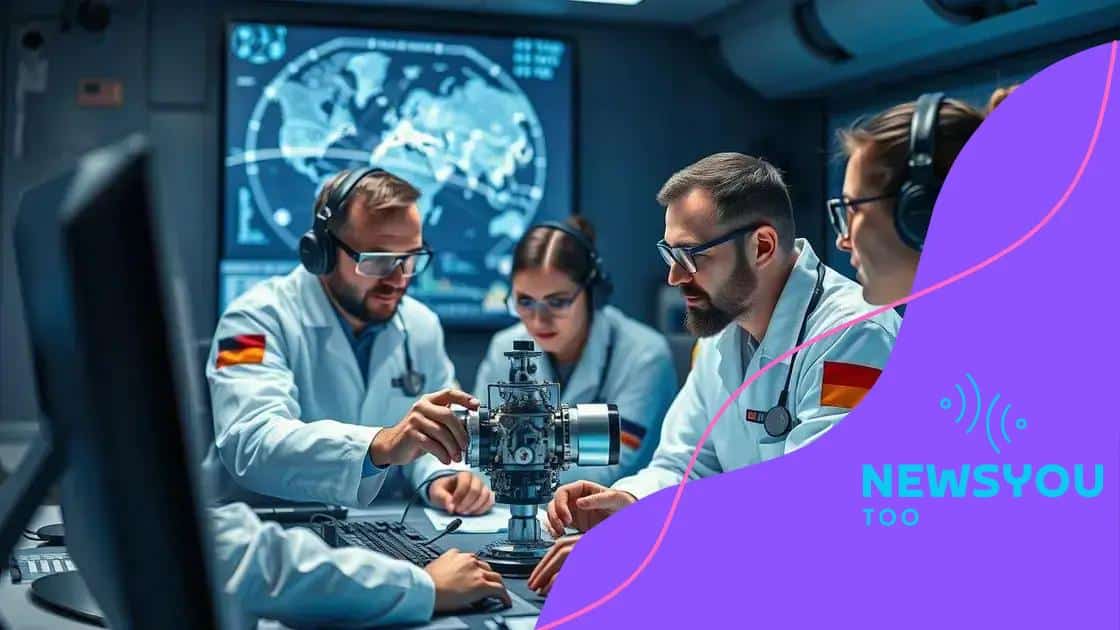How space exploration is fueling international collaboration

Anúncios
Space exploration fuels international collaboration by enabling countries to share resources, technologies, and expertise, which leads to improved efficiency, reduced costs, and enhanced safety in missions.
How space exploration is fueling international collaboration is a topic that captivates many. With countries coming together to explore the cosmos, it’s fascinating to see the innovations and friendships born from shared goals. What might this mean for our world?
Anúncios
The role of space exploration in diplomacy
Space exploration plays a significant role in shaping diplomatic relationships among countries. As nations strive to explore the final frontier, they often find common ground in their shared ambitions. This cooperation can lead to improved international relations and foster a spirit of unity.
One major aspect of this diplomacy is the collaboration on various space missions. Countries come together to pool their resources and expertise, which enhances the overall success of these endeavors. Working collaboratively, nations can focus on goals that benefit humanity, such as researching climate change or addressing future planetary threats.
Key Collaborations
Some of the notable collaborations include:
Anúncios
- The International Space Station (ISS), where astronauts from different nations work side by side.
- Joint missions such as NASA’s collaboration with ESA (European Space Agency) for missions to Mars.
- Sharing data and technologies to better understand the universe and enhance safety.
This type of partnership extends beyond scientific pursuit. Collaboration in space also signals an commitment to peace and mutual respect among nations. Countries often use their combined strength to tackle common challenges, reflecting a desire to maintain a stable and peaceful world.
Furthermore, diplomatic relationships established through space initiatives can lead to other forms of cooperation. Countries involved in space missions often find it easier to collaborate on issues like trade, environment, and education. This interconnectedness helps create bonds that can last long after a specific mission is completed.
The Benefits of Space Diplomacy
Working together in space diplomacy brings multiple benefits:
- Enhanced scientific knowledge and technological advancements.
- Strengthened alliances between countries.
- Increased public interest in science and technology.
In conclusion, the role of space exploration in diplomacy is multifaceted. As countries collaborate to achieve greater things, they not only advance their scientific knowledge but also build stronger, more peaceful relationships.
Key international collaborations in space missions
Key international collaborations in space missions showcase how nations can work together for a common goal. These partnerships have resulted in groundbreaking discoveries and innovations that no single country could achieve alone. As the landscape of space exploration evolves, collaboration becomes essential for tackling challenges like resource constraints and technical complexities.
One of the most notable examples is the International Space Station (ISS). This massive structure orbits Earth and serves as a laboratory for scientific research. It involves collaboration between space agencies from the United States, Russia, Europe, Japan, and Canada. Each partner brings unique expertise, contributing to research in fields ranging from biology to astronomy.
Examples of Successful Collaborations
Several key collaborations highlight the success of working together:
- The joint Mars missions, like NASA’s Perseverance and ESA’s ExoMars, which share data and technologies.
- The Global Precipitation Measurement (GPM) mission, where NASA and JAXA (Japan) work to improve weather forecasting.
- Multi-national satellite programs like the European Space Agency’s Copernicus, focusing on Earth observation.
These ventures emphasize the benefits of shared knowledge. By pooling resources, nations can reduce costs and accelerate discoveries. For instance, programs like the Mars Sample Return mission rely on input and technology from multiple countries, allowing for a more robust approach.
Additionally, these collaborations strengthen diplomatic ties, fostering relationships that extend beyond the realm of space. They create opportunities for cultural exchanges and enhance national prestige in the scientific community.
The Future of Space Collaboration
Looking ahead, the future of space collaboration appears bright. As interest in lunar exploration grows, alliances are forming to establish a sustainable presence on the Moon. Notably, the Artemis program, led by NASA, invites international partners to help pave the way for the next phase of human exploration.
Furthermore, the need to address global issues like climate change and asteroid threats will drive even more international cooperation. With resources and expertise so distributed, countries are motivated to share their findings and techniques, leading to broader solutions to these pressing challenges.
Benefits of shared technology in space

Shared technology in space exploration offers numerous benefits that enhance scientific understanding and foster international partnerships. When countries collaborate, they can utilize each other’s innovations, leading to faster advancements in technology.
One of the main advantages of using shared technology is the reduction of costs. By pooling resources, nations can decrease the financial burden of expensive missions. This allows for a more efficient allocation of funds, ensuring that more projects can be developed simultaneously. Additionally, shared technology enables countries to share risks. For instance, if one nation contributes technology for a mission, other nations can benefit from its success without shouldering the entire risk themselves.
Examples of Shared Technology
Many successful space missions highlight the benefits of shared technology:
- The Hubble Space Telescope, where NASA collaborated with ESA to strengthen the scientific output.
- The European Space Agency’s Sentinel satellites, which monitor Earth’s environment and climate.
- The Mars Science Laboratory, which involved technology exchange between various space agencies.
This sharing of knowledge not only speeds up innovation but also improves the results of missions. When countries work together, they can test and implement new technologies that enhance safety and efficiency.
Improving Safety and Efficiency
Shared technology can significantly improve safety in space missions. With multiple experts from different nations working on systems and tools, there’s greater scrutiny and testing. This collaborative approach leads to the identification of potential issues early on, minimizing risks during operations.
Moreover, shared technological resources allow for more efficient missions. For example, countries can develop and utilize shared communication platforms that streamline the exchange of data. This makes it easier for scientists to collaborate across borders and share findings.
Challenges faced in global space initiatives
Global space initiatives face several challenges that can impact their success and sustainability. As countries collaborate on ambitious projects, understanding these obstacles becomes essential for effective planning and execution.
One major challenge is securing funding for expansive space missions. Since space exploration requires significant investment, countries must prioritize budgets and justify expenses to their governments. For smaller countries, this can be especially difficult, often leading to reliance on larger space agencies for support.
Technological Limitations
Technological limitations also present hurdles in global space initiatives. Each country may have unique capabilities and expertise, leading to disparities in resources and technical know-how. These differences can result in challenges when integrating technologies across international partnerships. Moreover, some technologies may not meet the universal standards required for complex missions.
Despite these technological hurdles, nations continue to find ways to adapt. Enhanced communication and collaborative platforms allow for better integration and problem-solving.
Political and Regulatory Barriers
Political issues can also create roadblocks in global space efforts. Different countries may have varying regulations and policies regarding space exploration, leading to potential conflicts during joint missions. National priorities can shift, affecting long-term agreements and spaces collaborations. Thus, fostering diplomatic relations becomes key to maintaining successful partnerships.
Additionally, regulatory frameworks for satellite launches and orbital activities can create complications. With an increasing number of satellites being deployed, managing space traffic and ensuring safety has become more vital. These concerns can complicate international mission planning.
Future prospects for international space cooperation
The future prospects for international space cooperation are bright and full of potential. As nations face shared challenges like climate change and resource management, they recognize the importance of working together in space. This collaboration is essential not just for exploration, but also for fostering peaceful relationships.
One significant aspect that will shape the future of space cooperation is increased investment in shared projects. Countries are starting to fund programs that focus on long-term goals, such as colonizing Mars or establishing permanent bases on the Moon. These ambitious plans require a unified global effort to pool resources, knowledge, and technology.
Emerging Partnerships
New alliances are forming as countries explore collaboration opportunities:
- The Artemis program, which invites international partners to contribute to lunar exploration.
- Joint research initiatives to develop sustainable technologies for space travel.
- Collaborative efforts to address space debris and enhance orbital safety.
These partnerships signify a collective commitment to tackling the challenges of space exploration. Nations realize that by sharing expertise and data, they can speed up advancements and mitigate potential risks.
Technological Innovations
Technological innovations will play a crucial role in future collaborations. Advances in communication and propulsion systems can enhance mission efficiency and safety. For example, next-generation rockets may enable faster travel to distant celestial bodies, allowing for more frequent missions.
Furthermore, the development of artificial intelligence and machine learning can revolutionize space operations. These technologies can help manage complex data from multiple sources, aiding collaborative research and improving decision-making.
As we look to the future, the increasing presence of private space companies will also influence international cooperation. These companies often seek partnerships with governments and other entities, adding a dynamic element to the traditional space landscape.
FAQ – Frequently Asked Questions About International Space Cooperation
Why is international cooperation important for space exploration?
International cooperation is crucial as it allows countries to share resources, knowledge, and technologies, leading to more efficient and successful space missions.
What are some examples of successful international space collaborations?
Examples include the International Space Station (ISS), the Artemis program, and joint missions to Mars.
What challenges do countries face in space cooperation?
Countries may encounter funding issues, technological disparities, political obstacles, and differing regulations that can complicate international collaborations.
How can shared technology benefit space missions?
Shared technology can reduce costs, improve safety, and enhance mission efficiency by allowing countries to leverage each other’s innovations and expertise.





